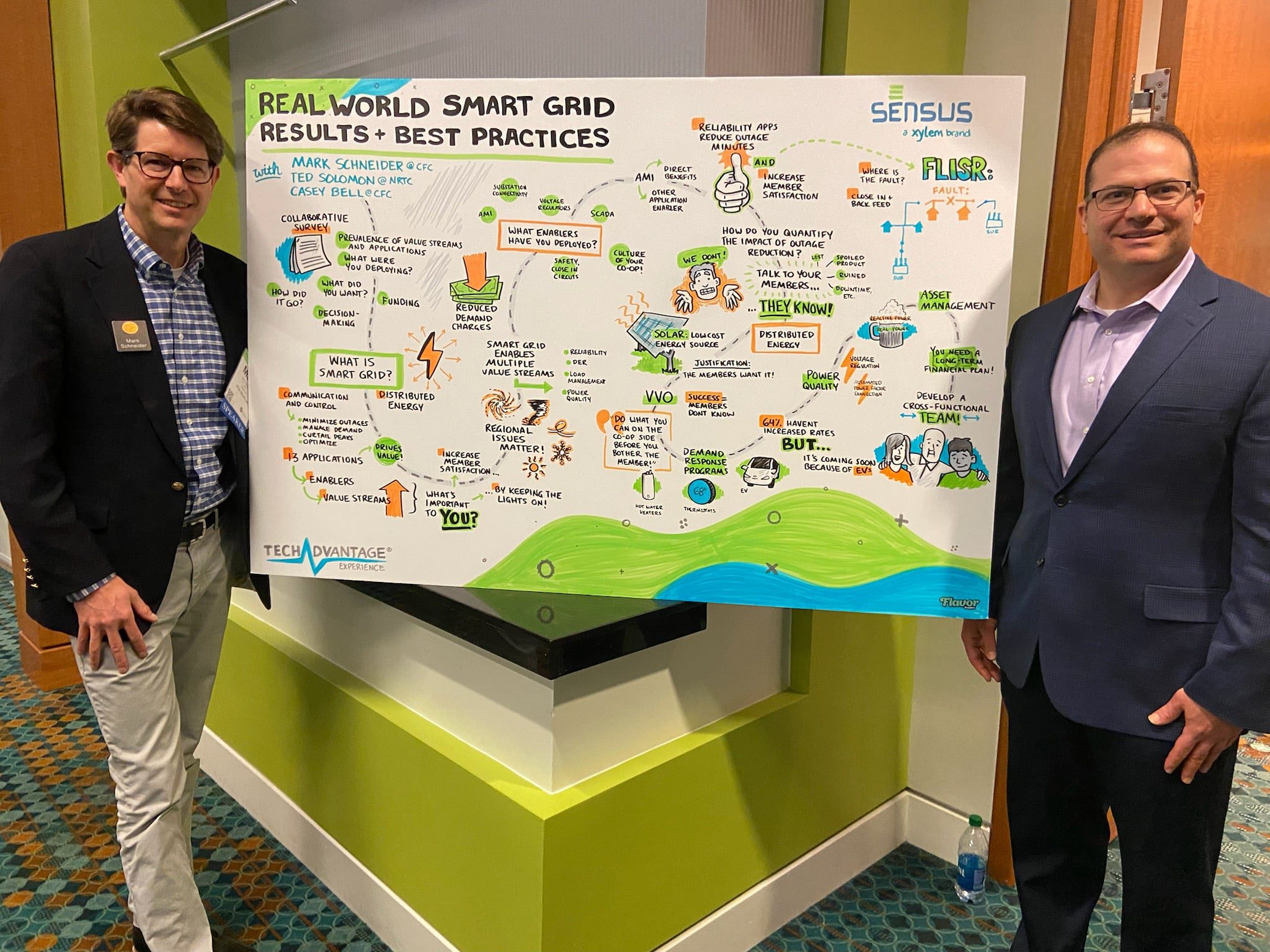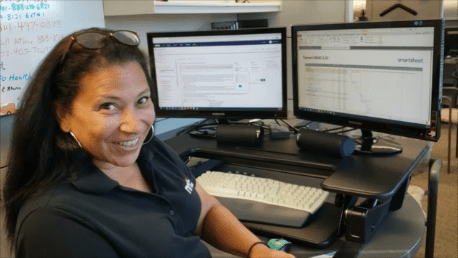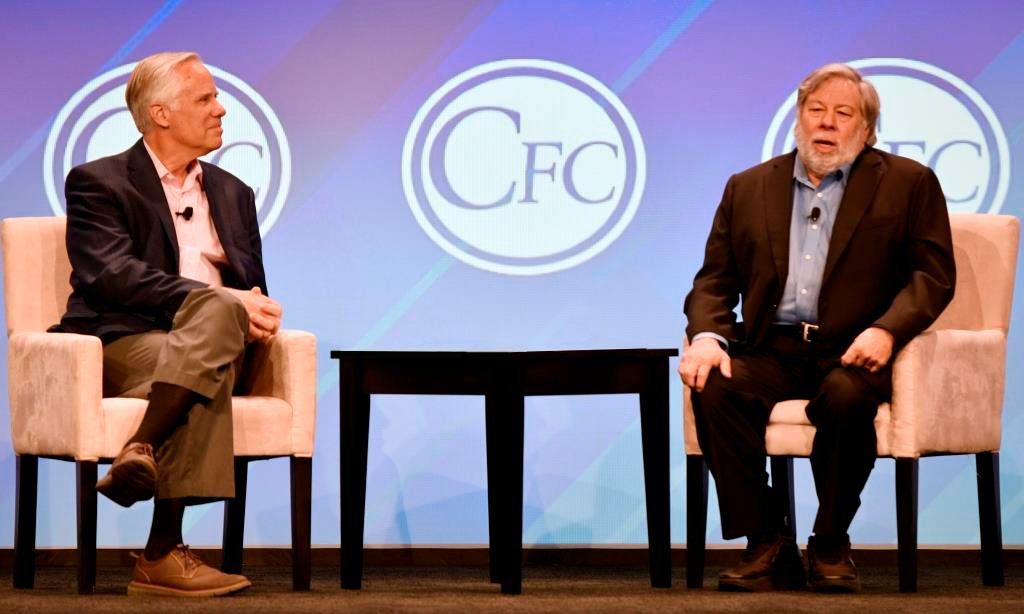NRTC TechAdvantage Speakers Share Experience From a Long List of Topics
Randy Sukow
|

With divisions covering all aspects of broadband, the smart grid, internet managed services and mobile phone and data communications, NRTC has experts who can speak to any communications network construction or operational issue. NRTC members regularly benefit from that experience. Those attending NRECA’s TechAdvantage Conference in Nashville this week saw it for themselves.
Along with knowledge, this year’s NRTC speakers looked for ways to make their presentations more accessible and “fun.”
Smart Grid Best Practices and Expectations
Ted Solomon, VP, Strategy and Corporate Development, co-presented a session highlighting the Rural Electric Cooperative Smart Grid Benchmarking Report: Creating Value with Smart Grid Applications (PDF). NRTC and CFC co-authored the report which is a resource to electric co-op planning smart grid investments and construction projects. NRTC and CFC surveyed cooperatives that have already made such investments, asking their motivations for deploying smart grid and the nature of any benefits that resulted.
Along with a review of the report, Solomon and co-presenter Mark Schneider CFC’s VP, Industry Research and Consulting, added an interactive element to the session. They re-asked the report’s survey questions to the TechAdvantage audience to measure whether there were any changes since the report’s release last year.
For example, one of the findings of the benchmarking report was that cooperatives hope to increase member satisfaction through smart grid deployments. “This room answered just like our research and just like most audiences do,” Solomon said. You are in business for your members. The thing that comes up most frequently is increased member satisfaction, but how do you increase member satisfaction? Produce reliable affordable energy.”
However, some of the Nashville audience’s responses differed slightly from the benchmarking report. Asked what smart grid technologies they had deployed or were strongly considering for deployment, the audience gave some unexpected answers.
“This is one where we’re seeing a little bit different response than we saw in our survey. Volt/VAR is making a strong charge here and it really wasn’t as prevalent among our [benchmarking report] respondents,” Schneider said. Solar and storage showed weaker numbers at the session compared to the earlier survey.
Wireless Networks Filling Many Roles for the Utility

Joe Walsh, NRTC’s VP, Smart Grid Advisory and Networks, predicts that in 10 or 15 years, electricity providers typically will operate with three communications network technologies: fiber optic, microwave in cases where it is not feasible to connect substations with fiber and LTE “to handle the rest of the communications.”
LTE has an edge, Walsh said, because it is an open standard with many technology developers creating new devices. The new devices are creating new applications for the technology within electric companies and other business, which, in turn, leads to falling prices. Private LTE (pLTE) is the exact same technology that smartphones users have accessed for more than a decade. LTE in many cases will be more cost-effective than the now emerging 5G devices, he said.
Walsh chose to format the TechTalk informally – “three guys talking at a bar” – with himself (pictured left), Joshua Pepple, NRTC’s director, Smart Grid Technology Planning (right), talking about real-world situations with Justin McCann, VP, Engineering at West Kentucky Rural Electric Cooperative. West Kentucky EC has been working with NRTC to test some pLTE applications.
The three touched on a long list of potential pLTE functions, including:
- AMI and synergies from using towers and other infrastructure already in place for AMI;
- radio dispatch in areas where cellular coverage is poor;
- location applications as an alternative to GPS;
- connecting sensors to monitor several forms of equipment;
- connecting security cameras and as well cameras mounted to drones.
West Kentucky EC is conducting its tests using an experimental license from the FCC, McCann said. Walsh predicted that cooperatives in the future will be able to use 3.5 GHz Citizens Broadband Radio Service (CBRS) to support pLTE. The FCC designed the General Authorized Access (GAA) tier of that service to give users access to spectrum without long time delays or excessive expense.
Managing Massive Amounts of Network Data

In early 2021, Chris Beatson, chief technology officer for NRTC Managed Services (pictured) and Marcellus Nixon, VP, Internet Services for rural electric provider United Cooperative Services in Texas were discussing UCS’s broadband network under construction. A challenge, they found, was monitoring all the small details that needed attention on the network.
“We white boarded a whole bunch of stuff, when Marcellus said, ‘On the electric side, we have this thing called SCADA. We can see everything we need to see in the electrical grid with all the pieces of equipment. It would be really great to have SCADA on the broadband side,’” Beatson said during a TechAdvantage session he co-presented with Nixon. “Ever since then we have been collaborating and figuring out how to get all of this data into an easy-to-consume set of dashboards.”
It is important to organize data in the broadband operation because of the many different types of people working on different functions needing different data. There are technical employees; sales and marketing people; finance/executive workers and support divisions. “They all have these different systems that they run on a day-to-day basis … If you peel back the onion, within those systems there are all kinds of complicated things,” Beatson said.
What complicates things even more are layers data from external sources – weather forecasts, billing systems, call center statistics and others that potentially influence business operations. “There are all types of data you want to pull from those myriad locations,” he said.
Tools Beaton and Nixon are developing could serve to reduce much of that complexity.


